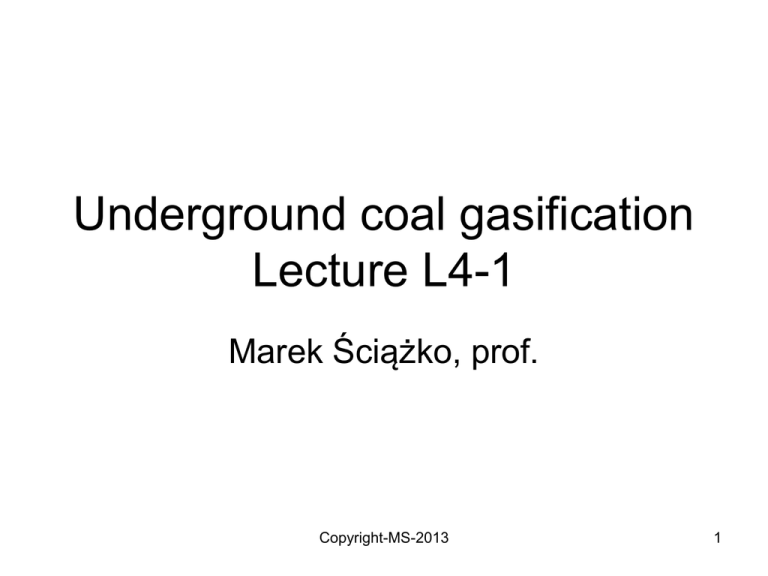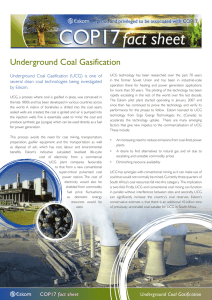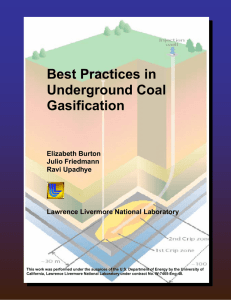Underground coal gasification
advertisement

Underground coal gasification Lecture L4-1 Marek Ściążko, prof. Copyright-MS-2013 1 Fundamental reactions for coal gasification Copyright-MS-2013 2 Example of an equilibrium calculation for coal gasification Copyright-MS-2013 3 • Underground coal gasification (UCG) converts coal in-situ into a gaseous product, commonly known as synthesis gas or syngas through the same chemical reactions that occur in surface gasifiers. • Gasification converts hydrocarbons into a synthesis gas (syngas) at elevated pressures and temperatures and can be used to create many products (electric power, chemical feedstock, liquid fuels, hydrogen, synthetic gas). • Gasification provides numerous opportunities for pollution control, especially with respect to emissions of sulfur, nitrous oxides, and mercury. UCG could increase the coal resource available for utilization enormously by gasifying otherwise unmineable deep or thin coals under many different geological settings. • A 300-400% increase in recoverable coal reserves is possible. Copyright-MS-2013 4 • • • • UCG has been tested in many different experimental tests in many countries. The U.S. carried out over 30 pilots between 1975 and 1996, testing bituminous, sub-bituminous, and lignite coals. Before that, the Former Soviet Union executed over 50 years of research on UCG, field tests and several commercial projects, including an electric power plant in Angren, Uzbekistan that is still in operation today after 47 years. Since 1991, China has executed at least 16 tests, and has several commercial UCG projects for chemical and fertilizer feedstocks. In 2000, Australia began a large pilot (Chinchilla) which produced syngas for 3 years before a controlled shut-down and controlled restart. As present, multiple commercial projects are in various stages of development in the U.S., Canada, South Africa, India, Australia, New Zealand, and China to produce power, liquid fuels, and synthetic natural gas. The leading institution in Poland is Central Mining Institute which is testing pilot scale unit. Copyright-MS-2013 5 General features of UCG • Initially, channel created in coal seam using special drilling techniques • As reaction proceeds, channel grows, creating underground ‘cavity’ • Volume of cavity increases progressively with progress of reaction • Main features: – – – – – – – – Cavity growth is more in vertical direction than horizontal direction Very little downward growth Elliptical cylindrical shape symmetrical about injection well Largest in vicinity of injection well Thin char layer on the periphery of cavity Slag nearer the base of cavity Cavity bottom filled with ash, char and coal Open void space at the top Copyright-MS-2013 6 Components of UCG Copyright-MS-2013 7 World-wide distribution of UCG Copyright-MS-2013 8 Advantages of UCG • • • Underground coal gasification (UCG) is the in-situ conversion of coal into combustible gases. A complex process involving chemical reactions, heat and mass transfer, complex flow dynamics & growing cavity dimensions. Advantages over conventional process are: – Low dust and noise. – No ash handling at power stations – No coal stocking and transportation – Larger coal resource exploitation – Disadvantages–Surface subsidence–Aquifer water contamination Copyright-MS-2013 9 Potential Limitations and Concerns for UCG • • • • • UCG can have significant environmental consequences: aquifer contamination, and ground subsidence. While a framework can be constructed from current knowledge that can eliminate or reduce these environmental risks, it is important to proactively address this constraint on siting and operation of any UCG projects; While UCG may be technically feasible for many coal resources, the number of deposits that are suitable may be much more limited because some may have geologic and hydrologic features that increase environmental risks to unacceptable levels; UCG operations cannot be controlled to the same extent as surface gasifiers. Many important process variables, such as the rate of water influx, the distribution of reactants in the gasification zone, and the growth rate of the cavity, can only be estimated from measurements of temperatures and product gas quality and quantity; The economics of UCG has major uncertainties, discussed later, that are likely to persist until such times as a reasonable number of UCG-based power plants are built and operated; UCG is inherently an unsteady-state process, and both the flow rate and the heating value of the product gas will vary over time. Any operating plant must take this factor into consideration. Copyright-MS-2013 10 Worldwide UCG operations experience with respect to coal seam depth and thickness Copyright-MS-2013 11 Conceptual Design of the Chinchilla Project (Blinderman, 2003). Copyright-MS-2013 12 Gas production history at Chinchilla Copyright-MS-2013 13 Typical plan view of the Soviet process • The dotted lines are meant to show the location of the underground linkage channels formed in the coal by a countercurrent combustion step in preparation for gasification. • The production phase of gasification is carried out by concurrent combustion in the channels. Concurrent and countercurrent refer to the flame front propagating in the same or opposite direction as the gas flow, respectively (Gregg et al., 1976). Copyright-MS-2013 14 Production data for Angren station (former Soviet Union) Copyright-MS-2013 15 Minimal requirements for UCG siting and operation TDS – total dissolved solids Copyright-MS-2013 16 Modeling of coal gasification Underground coal seam acts as a chemical reactor! Mathematical models should contain: •Kinetic constants •Thermo-mechanical properties •Cavity formation, evolution •Mathematical models for UCG are useful to visualize underground phenomena •Examine safety aspects minutely •Save on expensive technology Copyright-MS-2013 17 Velocity Contours of Lab –scale Model UCG Cavity Copyright-MS-2013 18 Temperature development in a coal seam Copyright-MS-2013 19




